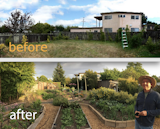Collection by Kevin Lawrence
Garden
Tasked with renovating a 1950s ranch in Northern California, Ogawa Fisher Architects revived an existing Japanese garden at the center of the home as a central organizing element. Low-slung, wide decks (inspired by the Japanese “engawa,” or elevated walkway) and deep roof soffits expand the living spaces, frame views, and blur the boundaries between inside and outside. The garden is the second of three courtyards that orients the various wings of the home from front to back, creating a vast sense of openness while also maintaining privacy from other areas of the house and the street.
For the past decade, Sasha has gradually transformed a thirsty and parched, Petaluma adobe backyard into a food-producing mini-farm, eco-friendly homestead and sustainable living center. She focus on using sustainable permaculture landscaping practices toward building a more resilient existence, rooted in wiser water use.
Petaluma Springs urban garden provide essential wildlife habitat and produce an abundance of food. Our goal is to reduce waste and pollution, conserve natural resources and create vibrant landscapes and gardens.
GARDEN OVERVIEW:
California native, Drip Irrigation, Drought tolerant, Edible garden, Graywater system, Lawn conversion/replacement, Lawn-free landscape, Permeable surfaces, Pesticide free, Rainwater harvesting system, Rain garden/Swales, Reclaimed/Recycled materials, Sheet mulching, Smart irrigation controller, Urban homestead, Wildlife Habitat









